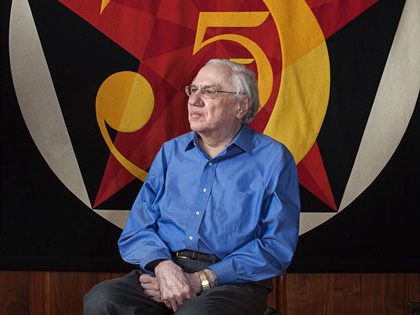The Archaeological Conservancy was saddened to announce that founder Jay T. Last passed away in Los Angeles on November 11, 2021 at the age of 92. Read more about his life and accomplishments in his full obituary below.
—————————
Jay T. Last
October 18, 1929 – November 11, 2021

Jay T. Last passed away peacefully in Los Angeles on November 11.
Physicist, Silicon Valley pioneer, entrepreneur, author, art collector, and philanthropist, Jay was a brilliant visionary whose pioneering work had a profound impact on many aspects of the modern world.
He was born in Butler, Pennsylvania in 1929 and received a BS degree in Optics from the University of Rochester in 1951 and a Ph.D. degree in Physics from MIT in 1956. After graduation, he worked for a year with William Shockley, a Nobel Prize recipient for the invention of the transistor, at the Shockley Semiconductor Laboratories. In 1957, Jay was one of the group of eight who founded the Fairchild Semiconductor Corporation, which would later be noted as the start of Silicon Valley. At Fairchild, his team developed the first commercial silicon planar transistors. He then directed the research and development group that produced the first integrated circuit chips.
In 1961 Jay joined Teledyne, Inc. and created a semiconductor division of the company, which developed and manufactured complex integrated circuit chips for various Teledyne programs and for various space and military applications. Many of these circuits were used in the control and data systems for the first space voyage to the moon. He later became Vice President for Technology, overseeing more than 150 divisions by the mid-1970s.
Jay left Teledyne in the late 1970s and became involved with various venture capital entities. While he transitioned to other projects, he continued to take a strong interest in documenting the history of the initial development of silicon transistors and integrated circuits, providing research materials for several books on this history.
Jay founded Hillcrest Press and published books on California art, ethnic art, and graphic arts. He was a founder of the Archaeological Conservancy in 1980, dedicated to preserving American archaeological sites. Over 555 sites in more than 45 states have been saved by the Conservancy to date, and the organization now has a membership of over 23,000.
When he moved to Southern California in 1970, Jay was attracted by the orange box labels for sale at local flea markets, and he built up a collection of these colorful examples of advertising art. He wrote a book on these labels with Gordon McClelland, California Orange Box Labels (1984). While writing this book, he became interested in the color lithographic techniques used to print the labels, and investigated the history of American color lithography. Jay assembled what became the largest private collection of lithographic prints, color plate books, theatrical and circus posters, advertising posters, sheet music, advertising cards, pamphlets, game boards, city views, and product labels. Beyond art and lithography, his collection has proved to be valuable for research on many aspects of nineteenth century American social history, with special emphasis on the dynamic final quarter of the 1800s. To provide public access to this collection, now numbering over 100,000 items, it has been donated to the Huntington Library, Art Museum, and Botanical Gardens. An exhibition of selected items from the collection was held at the Huntington from October 2009 through February 2010.
Jay had a lifelong interest in Africa and its art, and he built up a major collection from West and Central Africa. A particular interest over a forty-year period was objects from the Lega tribe in the eastern Congo, who carved diverse abstract figures and masks as a key element of their social organization. Jay donated his collection to the Fowler Museum at UCLA. The material formed the subject of an exhibition at the Fowler in 2001 and a book written by Elizabeth Cameron, Lega Art.
Jay was a generous philanthropist in the areas of education and art, providing scholarships and supporting numerous museums and educational institutions. Although Jay was a collector of historical art, his goal was to preserve it for the future and the public. His museum displays would omit the traditional “on loan from the collection of …” since his perspective was that he was the caretaker and not the creator of the art.
Jay was an avid traveler and mountain climber. His wife, Deborah, joined him on many trips around the globe. You could also find the pair regularly enjoying Dodger games at the stadium or on TV.
Jay received numerous awards. In 1999, he received the Hutchison Medal from the University of Rochester. He received the 2005 Maurice Rickards Award from the Ephemera Society of America for his important contributions to the field of ephemera studies. In 2007, he received the Newman Award for the outstanding book of the year for The Color Explosion. In May 2011, Jay received the Legends of California Award from the California Historical Society.
At his time of passing Jay was survived by his wife, Deborah R. Last, and his nephew Michael Last.
Published by San Francisco Chronicle from Nov. 17 to Nov. 22, 2021.




